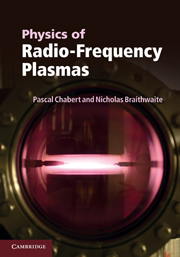Book contents
- Frontmatter
- Contents
- Acknowledgements
- 1 Introduction
- 2 Plasma dynamics and equilibrium
- 3 Bounded plasma
- 4 Radio-frequency sheaths
- 5 Single-frequency capacitively coupled plasmas
- 6 Multi-frequency capacitively coupled plasmas
- 7 Inductively coupled plasmas
- 8 Helicon plasmas
- 9 Real plasmas
- 10 Electrical measurements
- Appendix: Solutions to exercises
- References
- Index
6 - Multi-frequency capacitively coupled plasmas
Published online by Cambridge University Press: 04 April 2011
- Frontmatter
- Contents
- Acknowledgements
- 1 Introduction
- 2 Plasma dynamics and equilibrium
- 3 Bounded plasma
- 4 Radio-frequency sheaths
- 5 Single-frequency capacitively coupled plasmas
- 6 Multi-frequency capacitively coupled plasmas
- 7 Inductively coupled plasmas
- 8 Helicon plasmas
- 9 Real plasmas
- 10 Electrical measurements
- Appendix: Solutions to exercises
- References
- Index
Summary
In the previous chapter it was shown that single-frequency capacitive discharges do not allow ion flux and ion energy to be varied independently. To overcome this limitation, inductive discharges may be used, in which the plasma is produced by an RF current in an external coil while the wafer-holder is biased by an independent power supply. These discharges are studied in the next chapter.
It should also be possible to achieve a reasonable level of control of the ion flux independently of the ion energy, by using dual-frequency CCP. Figure 6.1 shows the inspiration for this assertion: the ion energy is plotted as a function of the ion flux at the grounded electrode of a symmetrical CCP for three different single-frequency discharges. The symbols are measurements from a planar probe and from a retarding field analyser inserted in the grounded electrode (see Chapter 10 for background on these measurements). The lines in the figure are from a global model similar to that developed in the previous chapter. It appears as expected that the trajectory in flux–energy space is a single line for each driving frequency. At 13.56 MHz, there is a clear trend towards high ion energies and small ion fluxes, while at 81.36 MHz the opposite arises. Etching often requires ions to have energy in excess of 100 eV to enhance chemical reactions, but less than about 500 eV to avoid physical damage to the surface being etched, or to the photoresist mask.
- Type
- Chapter
- Information
- Physics of Radio-Frequency Plasmas , pp. 176 - 218Publisher: Cambridge University PressPrint publication year: 2011



